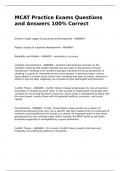Exam (elaborations)
MCAT Practice Exams Questions and Answers 100% Correct
- Course
- Institution
MCAT Practice Exams Questions and Answers 100% CorrectMCAT Practice Exams Questions and Answers 100% CorrectMCAT Practice Exams Questions and Answers 100% CorrectMCAT Practice Exams Questions and Answers 100% CorrectErikson's eight stages of psychosocial development - ANSWER - Piaget's stages o...
[Show more]



